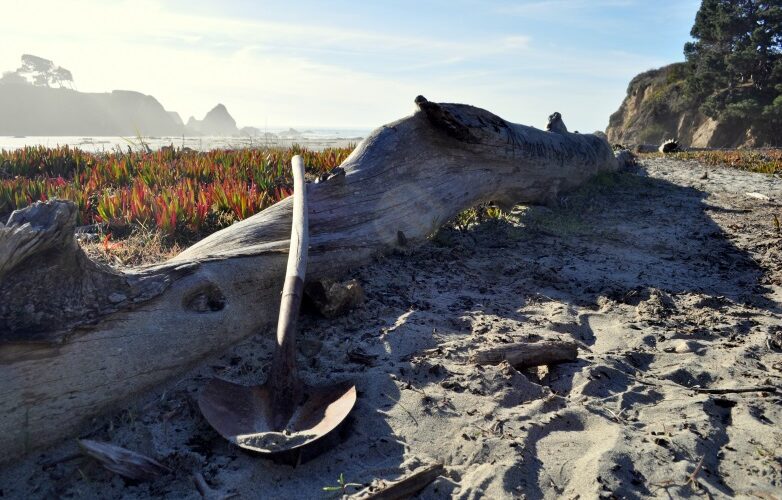Trout Unlimited Project at MLT’s Noyo River Redwoods
This project was completed by the fantastic Trout Unlimited’s North North Coast Coho Project in 2020. This massive undertaking to restore salmon habitat along the historic Skunk Train rail line in several spots where it crosses the Noyo River included work in MLT’s Navarro River Redwoods Preserve.
We are excited to share news of this success but would like to be clear that while MLT-held lands benefited greatly from this project, it was not organized or funded by MLT. This information comes from Trout Unlimited’s press release about the project’s completion.
Old failing culverts that blocked the upstream journey of salmon were replaced with modern railroad crossings that leave rivers accessible for wildlife and ensure safe passage for fish. This restored access for endangered Coho salmon and threatened steelhead to nearly two miles of spawning and rearing habitat in the upper watershed. The projects replaced two culverts along the Skunk Train railway and a third culvert on an adjacent timber road that prevented fish from utilizing valuable habitat in a watershed that is vital to Coho salmon recovery in the state.
Trout Unlimited’s partners on these projects include the Mendocino Railway (commonly known as the Skunk Train), the Soper-Wheeler Company, the Mendocino Land Trust, the California Department of Fish and Wildlife, NOAA Fisheries, the National Fish and Wildlife Foundation, Michael Love and Associates, AECOM, Granite Construction, the California Fish Passage Forum, The Nature Conservancy, and the Salmonid Restoration Foundation.
The Noyo River and its tributaries support Central California Coast Coho salmon, which are listed as endangered, and populations of Chinook salmon and steelhead trout, which are listed as threatened under the Endangered Species Act. California Central Coast Coho have undergone a precipitous decline in the last 100 years and are now on the brink of extinction.
Although the Noyo River is home to one of the most stable populations of California Coho, the federal recovery plan rates this population at moderate to high risk of extinction. From 2013-2018, the 5-year average for returning adult Coho was 2,755 (the recovery target for the Noyo is 4,000).
“Restoring access to more than 1 mile of Coho Salmon habitat in a watershed with consistent returns of Coho salmon gives me such hope for recovery of this species on the Mendocino Coast. Welcome home Coho salmon!” said Chris Ramsey, Senior Environmental Specialist with CDFW.
Both state and federal recovery plans for Coho salmon on the Mendocino Coast identify restoring fish passage and mitigating sediment sources along the Noyo River as important action steps for species recovery. Decrepit culverts prevent fish from moving throughout the river system and can cause erosion into streams, sometimes delivering amounts of sediment so large the impact on fish is catastrophic.
Anna Halligan, North Coast Coho Project Director with Trout Unlimited, said “One of the culverts under the Skunk Train was in such poor condition that the hillslope around it had begun to erode and was delivering fine sediment into the Upper Noyo River. A large storm event could have saturated the soils and caused slope failure which may have buried about 3 miles of the river under one foot of fine sediment, which is roughly equal to 840 full dump trucks.. This kind of disaster would not only impair water quality in the river, it could also significantly impact a salmon population that is showing signs of recovery and, if the culvert had collapsed, it would have affected tourism on the Skunk Train’s Willits line.”
The Noyo River is currently listed under the federal Clean Water Act as an impaired water body due to excessive sediment and elevated water temperatures. This project has been in the works since 2010, when Trout Unlimited commissioned a detailed assessment of sediment sources and fish passage barriers along the railway.
The construction phase of these projects began in June 2020 and was completed in October 2020. The two railway culverts were replaced with large structural steel arches. A third culvert on a private timber road directly upstream from one of the rail culverts was replaced with a bridge. The stream channels were also restored during construction, ensuring fish and other aquatic organisms will be able to migrate successfully.
“Large projects such as these require extensive cooperation, dedicated partners, and time. This project never would have happened without the investment of so many diverse groups all committed to Coho Salmon and their habitat,” said Ramsey.
These Noyo River projects also benefit local communities by employing local contractors, helping to sustain existing fisheries, and supporting a mainstay of the Fort Bragg and Willits tourism economy. “Projects like these can take a long time to get off the ground and require a lot of support from public and private entities, but their benefits are immediate and long-lasting,” said Halligan. “Clean water, healthy fisheries, and a robust local economy are good for everyone.”
Funding for these projects was provided by the California Department of Fish and Wildlife’s Fisheries Restoration Grant Program, the California Wildlife Conservation Board, the National Oceanic and Atmospheric Administration Restoration Center, the National Fish and Wildlife Foundation, the California Department of Fish and Wildlife Office of Spill Prevention and Response, the California Fish Passage Forum, The Nature Conservancy, and the Salmon Restoration Association (with funding raised from their annual World Largest Salmon BBQ event in Fort Bragg).



